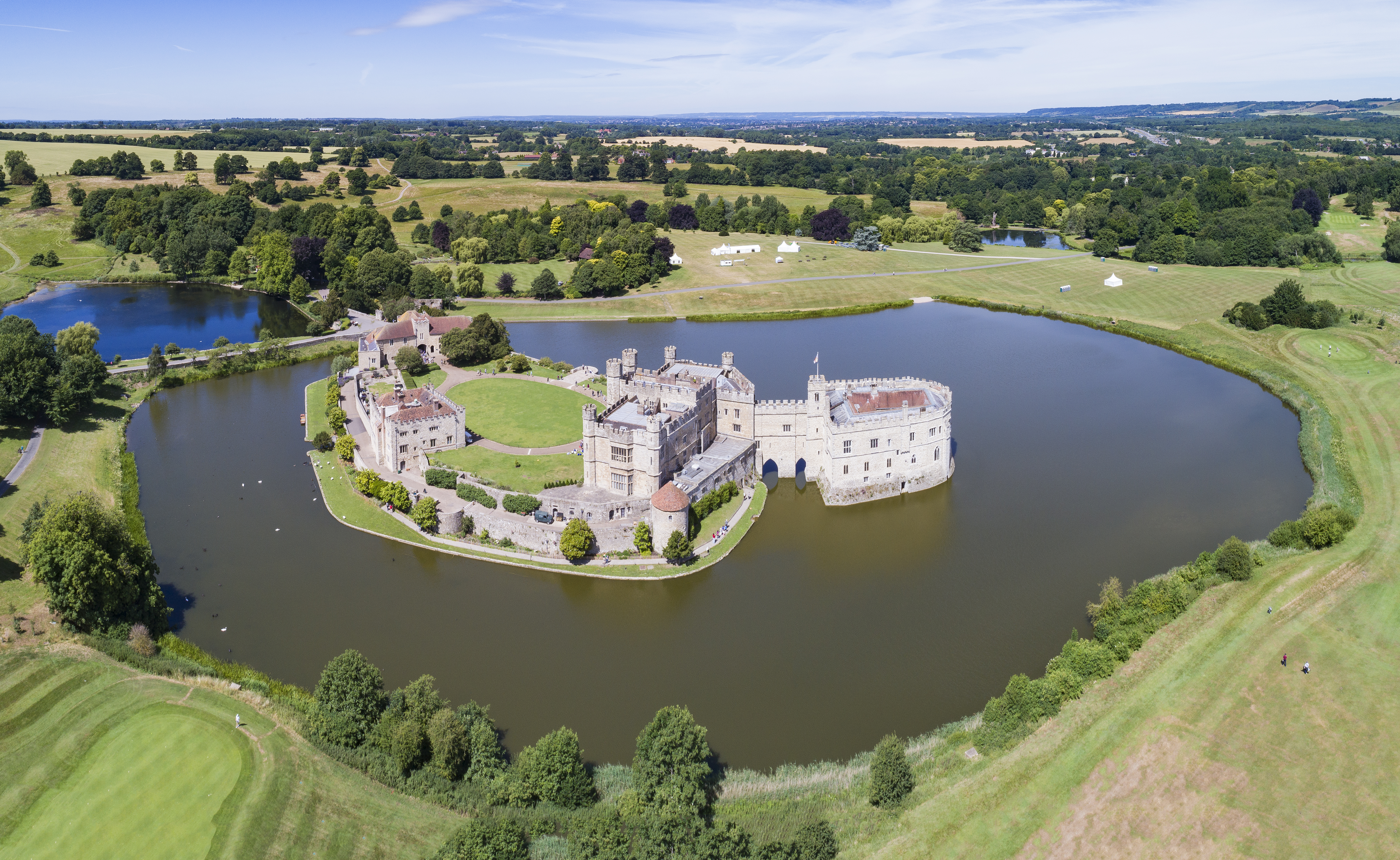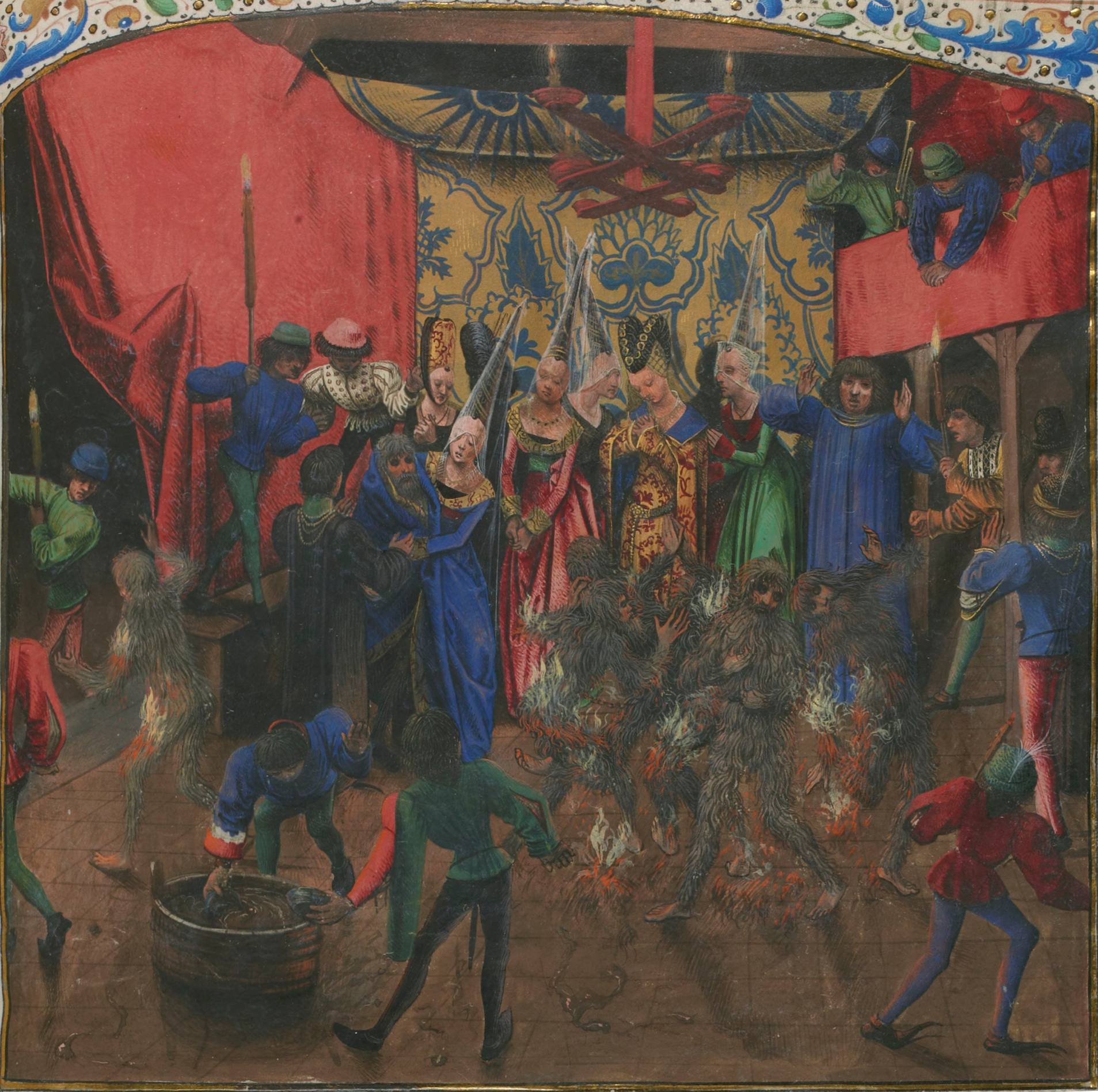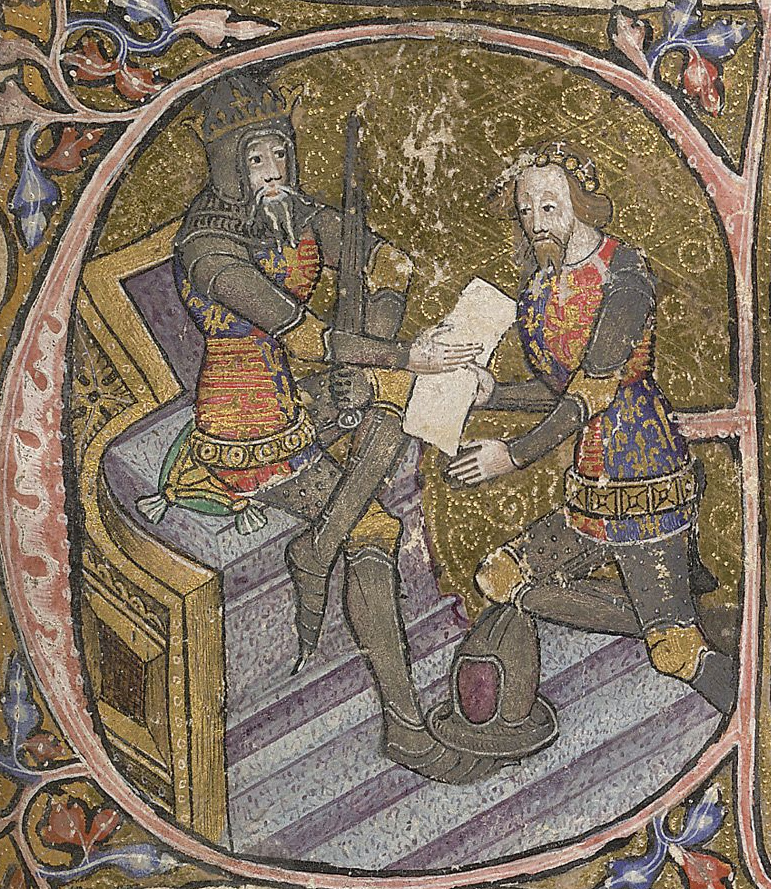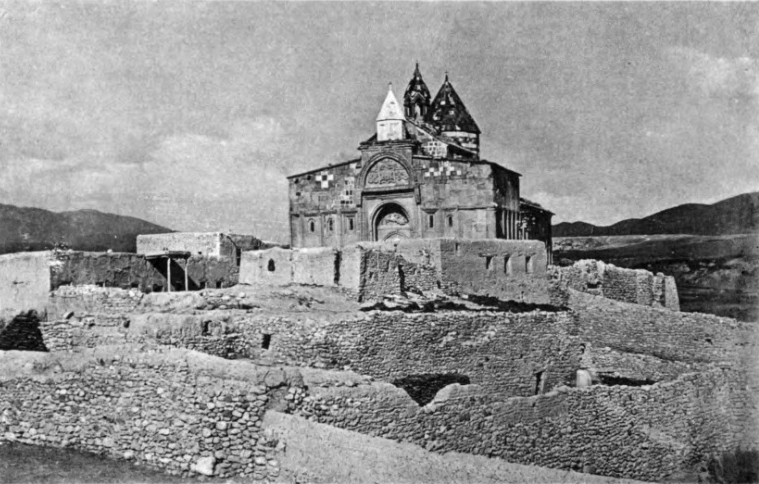|
Leeds Castle
Leeds Castle is a castle in Kent, England, southeast of Maidstone. It is built on islands in a lake formed by the River Len to the east of the village of Leeds and is a historic Grade I listed estate. A castle has existed on the site since 857. In the 13th century, it came into the hands of King Edward I, for whom it became a favourite residence; in the 16th century, Henry VIII used it as a dwelling for his first wife, Catherine of Aragon. The present castle dates mostly from the early 19th century. Its last private owner, Olive, Lady Baillie, left the castle in trust to open it to the public. It has been open since 1976. History Medieval and Tudor From 857, the site was owned by a Saxon chief called Led or Leed who built a wooden structure on two islands in the middle of the River Len. In 1119, Robert de Crevecoeur rebuilt it in stone as a Norman stronghold and Leeds Castle descended through the de Crevecoeur family until the 1260s. What form this Norman str ... [...More Info...] [...Related Items...] OR: [Wikipedia] [Google] [Baidu] |
Broomfield, Maidstone
Broomfield is a village in the Maidstone District of Kent, England, and forms part of the civil parish of Broomfield and Kingswood. It lies to the east of Maidstone. The village is located just upstream of Leeds Castle on the River Len, one of the tributaries of the River Medway. The parish church is dedicated to Saint Margaret. In the 16th and 17th centuries Broomfield was home to the first two generations of the Hatch family of bellfounders, who lived in the farmhouse at Roses Farm. Their output included the bell known as "Bell Harry", after which the central tower of Canterbury Cathedral is known.; . There is also a Broomfield, in East Kent, in the parish of Herne and Broomfield, on the outskirts of Herne Bay Herne Bay is a seaside town on the north coast of Kent in South East England. It is north of Canterbury and east of Whitstable. It neighbours the ancient villages of Herne, Kent, Herne and Reculver and is part of the City of Canterbury loca .... Referen ... [...More Info...] [...Related Items...] OR: [Wikipedia] [Google] [Baidu] |
Barbican
A barbican (from ) is a fortified outpost or fortified gateway, such as at an outer defense perimeter of a city or castle, or any tower situated over a gate or bridge which was used for defensive purposes. Europe Medieval Europeans typically built barbicans outside, or at the edge of, a main line of defenses, and connected them to defensive walls with a walled road called ''the neck''. Barbicans would thus control the entrance to a city or castle at the "choke point". In the 15th century, as siege tactics and artillery developed, barbicans began to lose their significance, but new barbicans were built well into the 16th century. Fortified or mock-fortified gatehouses remained a feature of ambitious French and English residences well into the 17th century. Portuguese medieval fortification nomenclature uses the term "barbican" ("") for any wall outside of and lower than the main defensive wall that forms a second barrier. The barrier may be complete, extensive or only protect p ... [...More Info...] [...Related Items...] OR: [Wikipedia] [Google] [Baidu] |
Francis I Of France
Francis I (; ; 12 September 1494 – 31 March 1547) was King of France from 1515 until his death in 1547. He was the son of Charles, Count of Angoulême, and Louise of Savoy. He succeeded his first cousin once removed and father-in-law Louis XII, who died without a legitimate son. A prodigious patron of the arts, Francis promoted the emergent French Renaissance by attracting many Italian artists to work for him, including Leonardo da Vinci, who brought the ''Mona Lisa'', which Francis had acquired. Francis's reign saw important cultural changes with the growth of central power in France, the spread of humanism and Protestantism, and the beginning of French exploration of the New World. Jacques Cartier and others claimed lands in the Americas for France and paved the way for the expansion of the first French colonial empire. For his role in the development and promotion of the French language, Francis became known as (the 'Father and Restorer of Letters'). He was also ... [...More Info...] [...Related Items...] OR: [Wikipedia] [Google] [Baidu] |
Froissart's Chronicles
Froissart's ''Chronicles'' (or ''Chroniques'') are a prose history of the Hundred Years' War written in the 14th century by Jean Froissart. The ''Chronicles'' open with the events leading up to the deposition of Edward II in 1327, and cover the period up to 1400, recounting events in western Europe, mainly in England, France, Scotland, the Low Countries and the Iberian Peninsula, although at times also mentioning other countries and regions such as Italy, Germany, Ireland, the Balkans, Cyprus, Turkey and North Africa. For centuries the ''Chronicles'' have been recognized as the chief expression of the chivalric culture of 14th-century England and France. Froissart's work is perceived as being of vital importance to informed understandings of the European 14th century, particularly of the Hundred Years' War. But modern historians also recognize that the ''Chronicles'' have many shortcomings as a historical source: they contain erroneous dates, have misplaced geography, give in ... [...More Info...] [...Related Items...] OR: [Wikipedia] [Google] [Baidu] |
Jean Froissart
Jean Froissart ( Old and Middle French: ''Jehan''; sometimes known as John Froissart in English; – ) was a French-speaking medieval author and court historian from the Low Countries who wrote several works, including ''Chronicles'' and ''Meliador'', a long Arthurian romance, and a large body of poetry, both short lyrical forms as well as longer narrative poems. For centuries, Froissart's ''Chronicles'' have been recognised as the chief expression of the chivalric revival of the 14th-century kingdoms of England, France and Scotland. His history is also an important source for the first half of the Hundred Years' War.Michael Jones (2004).Froissart, Jean (1337? – c. 1404). ''Oxford Dictionary of National Biography''. Life What little is known of Froissart's life comes mainly from his historical writings and from archival sources which mention him in the service of aristocrats or receiving gifts from them. Although his poems have also been used in the past to reconstruct aspe ... [...More Info...] [...Related Items...] OR: [Wikipedia] [Google] [Baidu] |
Anne Of Bohemia
Anne of Bohemia (11 May 1366 – 7 June 1394), also known as Anne of Luxembourg, was Queen consort of England, Queen of England as the first wife of King Richard II. A member of the House of Luxembourg, she was the daughter of Charles IV, Holy Roman Emperor and King of Bohemia, and Elizabeth of Pomerania. Her death at the age of 28 was believed to have been caused by Plague (disease), plague. Early life Anne had four brothers, including the Sigismund, Holy Roman Emperor, Holy Roman Emperor Sigismund, and one younger sister, Margaret of Bohemia, Burgravine of Nuremberg. She also had five half-siblings from her father's previous marriages, including Margaret of Bohemia, Queen of Hungary. She was brought up mainly at Prague Castle, and spent much of her early life in the care of her brother, King Wenceslaus IV of Bohemia. She could read German, Czech, and Latin. On her journey through Flanders on the way to her new life in England, she came under the protection of her uncle, Wence ... [...More Info...] [...Related Items...] OR: [Wikipedia] [Google] [Baidu] |
Richard II Of England
Richard II (6 January 1367 – ), also known as Richard of Bordeaux, was King of England from 1377 until he was deposed in 1399. He was the son of Edward the Black Prince, Edward, Prince of Wales (later known as the Black Prince), and Joan, Countess of Kent. Richard's father died in 1376, leaving Richard as List of heirs to the English throne, heir apparent to his grandfather, King Edward III; upon the latter's death, the 10-year-old Richard succeeded to the throne. During Richard's first years as king, government was in the hands of a series of regency councils, influenced by Richard's uncles John of Gaunt and Thomas of Woodstock. England at that time faced various problems, most notably the Hundred Years' War. A major challenge of the reign was the Peasants' Revolt in 1381, and the young king played a central part in the successful suppression of this crisis. Less warlike than either his father or grandfather, he sought to bring an end to the Hundred Years' War. A firm ... [...More Info...] [...Related Items...] OR: [Wikipedia] [Google] [Baidu] |
Isabella Of France
Isabella of France ( – 22 August 1358), sometimes described as the She-Wolf of France (), was List of English royal consorts, Queen of England as the wife of Edward II of England, King Edward II, and ''de facto'' regent of England from 1327 until 1330. She was the youngest surviving child and only surviving daughter of King Philip IV of France and Joan I of Navarre. Isabella was notable in her lifetime for her diplomatic skills, intelligence, and beauty. She overthrew her husband, becoming a "femme fatale" figure in plays and literature over the years, usually portrayed as a beautiful but cruel and manipulative figure. Isabella arrived in England at age 12 during a period of growing conflict between the king and the powerful baronial factions. Her new husband was notorious for the patronage he lavished on his favourite, Piers Gaveston, but the queen supported Edward during these early years, forming a working relationship with Piers and using her relationship with the French ... [...More Info...] [...Related Items...] OR: [Wikipedia] [Google] [Baidu] |
Bartholomew De Badlesmere, 1st Baron Badlesmere
Bartholomew was one of the twelve apostles of Jesus according to the New Testament. Most scholars today identify Bartholomew as Nathanael, who appears in the Gospel of John (1:45–51; cf. 21:2). New Testament references The name ''Bartholomew'' (, transliterated "Bartholomaios") comes from the ''bar-Tolmay'' "son of Tolmai" or "son of the furrows". Bartholomew is listed in the New Testament among the Twelve Apostles of Jesus in the three Synoptic Gospels: Matthew, Mark, and Luke, and in Acts of the Apostles. Tradition Eusebius of Caesarea's ''Ecclesiastical History'' (5:10) states that after the Ascension, Bartholomew went on a missionary tour to India, where he left behind a copy of the Gospel of Matthew. Tradition narrates that he served as a missionary in Mesopotamia and Parthia, as well as Lycaonia and Ethiopia in other accounts.''Encyclopædia Britannica'', Micropædia. vol. 1, p. 924. Chicago: Encyclopædia Britannica, Inc., 1998. . Popular traditions say that Bartho ... [...More Info...] [...Related Items...] OR: [Wikipedia] [Google] [Baidu] |
Margaret De Clare, Baroness Badlesmere
Margaret is a feminine given name, which means "pearl". It is of Latin origin, via Ancient Greek and ultimately from Old Iranian. It has been an English name since the 11th century, and remained popular throughout the Middle Ages. It became less popular between the 16th and 18th century, but became more common again after this period, becoming the second-most popular female name in the United States The United States of America (USA), also known as the United States (U.S.) or America, is a country primarily located in North America. It is a federal republic of 50 U.S. state, states and a federal capital district, Washington, D.C. The 48 ... in 1903. Since this time, it has become less common, but was still the ninth-most common name for women of all ages in the United States as of the 1990 census. Margaret has many diminutive forms in many languages, including Daisy, Greta, Gretchen, Maggie, Madge, Maisie, Marge, Margie, Margo, Margot, Marnie, Meg, Megan, ... [...More Info...] [...Related Items...] OR: [Wikipedia] [Google] [Baidu] |
Edward II Of England
Edward II (25 April 1284 – 21 September 1327), also known as Edward of Caernarfon or Caernarvon, was King of England from 1307 until he was deposed in January 1327. The fourth son of Edward I, Edward became the heir to the throne following the death of his older brother Alphonso, Earl of Chester, Alphonso. Beginning in 1300, Edward accompanied his father on Wars of Scottish Independence, campaigns in Scotland, and in 1306 he was Knight#Evolution of medieval knighthood, knighted in Feast of the Swans, a grand ceremony at Westminster Abbey. Edward succeeded to the throne the next year, following his father's death. In 1308, he married Isabella of France, Isabella, daughter of the powerful King Philip IV of France, as part of a long-running effort to resolve the tensions between the English and French crowns. Edward had a close and controversial relationship with Piers Gaveston, who had joined his household in 1300. The precise nature of Edward and Gaveston's relationship ... [...More Info...] [...Related Items...] OR: [Wikipedia] [Google] [Baidu] |
Windsor Castle
Windsor Castle is a List of British royal residences, royal residence at Windsor, Berkshire, Windsor in the English county of Berkshire, about west of central London. It is strongly associated with the Kingdom of England, English and succeeding British royal family, and embodies almost a millennium of architectural history. The original castle was built in the 11th century, after the Norman invasion of England by William the Conqueror. Since the time of Henry I of England, Henry I (who reigned 1100–1135), it has been used by the reigning monarch and is the longest-occupied palace in Europe. The castle's lavish early 19th-century state apartments were described by the art historian Hugh Roberts (art historian), Hugh Roberts as "a superb and unrivalled sequence of rooms widely regarded as the finest and most complete expression of later Georgian taste".Hugh Roberts, ''Options Report for Windsor Castle'', cited Nicolson, p. 79. Inside the castle walls is the 15th-ce ... [...More Info...] [...Related Items...] OR: [Wikipedia] [Google] [Baidu] |










